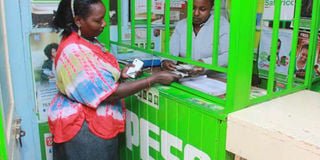M-Pesa transactions rise to Sh15bn daily after systems upgrade

A woman withdraws money from an M-Pesa shop in Nyeri town on October 7, 2014. In a report the firm shared with the Sunday Nation, Safaricom says Kenyans made 4.1 billion M-Pesa transactions last year, which was almost double the 2.8 billion in 2014. PHOTO | JOSEPH KANYI | NATION MEDIA GROUP
What you need to know:
- At Sh15 billion, the sum is equal to the amount that the Treasury allocated for military modernisation last year.
- It says the number of M-Pesa customers in Kenya now stands at 21 million, meaning there were about three million new users in the past year.
- Mr George Ojiwa, an engineer at the M-Pesa financial services support desk, attributed the reduced number of disruptions to the control that the technical teams have over the M-Pesa equipment.
The amount of money that Kenyans transact daily through M-Pesa is half of what it cost to construct the Thika Superhighway, latest figures from Safaricom reveal.
At Sh15 billion, the sum is equal to the amount that the Treasury allocated for military modernisation last year.
In a report the firm shared with the Sunday Nation, Safaricom says Kenyans made 4.1 billion M-Pesa transactions last year, which was almost double the 2.8 billion in 2014.
It says the number of M-Pesa customers in Kenya now stands at 21 million, meaning there were about three million new users in the past year.
The report centers on M-Pesa’s progress since its servers were moved from Germany to Kenya and a subsequent upgrade of the operating system.
In a single second, the document says, the system now receives up to 900 transactions, which places M-Pesa in the league of the world’s busiest payment companies.
“Currently, we process 14 million transactions daily,” the report says.
This figure could evoke awful memories among Kenyans who used the service before April 2015 — when the system could only cope with 320 transactions a second — with operations slowing down on weekends and holidays.
Nairobi-based M-Pesa agent Anne Wambui recalls that during those days, she lost up to Sh5,000 due to delays.
The losses occurred when she received a message to release cash to a customer while the system had not deducted the sum from the customer’s account.
Another Nairobi agent, Mr Nobert Wandera, remembers that there were days when he would not do business from morning till evening.
EFFICIENCY
But these days, there has not been a single instance of M-Pesa outage since October 2015, says M-Pesa Head of Product Development Brian Wamatu.
“We used to have hitches here and there, especially on Fridays when we had high traffic,” Mr Wamatu told the Sunday Nation during an interview with senior M-Pesa officials.
“The average transaction is six seconds, from up to 20 seconds in the old system. We have had fewer downtimes. We have not had a single downtime in the last six months, even during the festive season,” he added.
Mr George Ojiwa, an engineer at the M-Pesa financial services support desk, attributed the reduced number of disruptions to the control that the technical teams have over the M-Pesa equipment.
“The operations team is structured in such a way that we have 24/7 visibility of the system. And because the system is here locally, we have visibility in the software elements, application and also in the hardware components,” he said.
One of the changes that the new software has enabled the team to implement is the “Hakikisha” service that was introduced last October.
It allows a sender to confirm the recipient before finalising a transaction.
CONFIRMATION
M-Pesa technicians increased the number of seconds within which a sender can confirm the recipient from 15 to 20 seconds.
“We got feedback from customers that before they could confirm the message, it had disappeared,” said Mr Wamatu.
Following the complaints, the team added five more seconds — a change that had to go through an internal testing process before it was rolled out.
Besides Hakikisha, the new system also allows users to get statements via email every month.
It also enabled the introduction of a new M-Pesa menu and gave the team the ease of working with third party product developers.
M-Pesa offices have been receiving an average of 900 requests every month, with people seeking to incorporate the payment system into their businesses.





